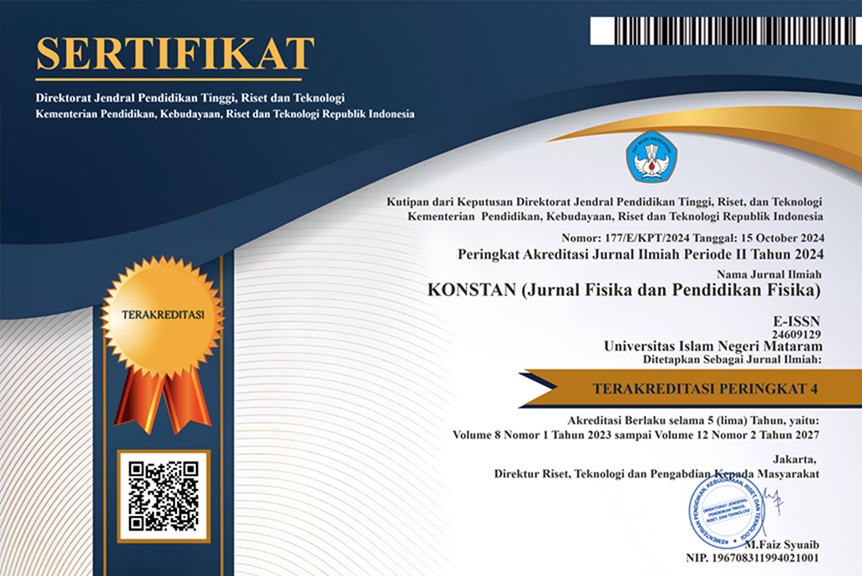
Ethics Statement
Publication Ethics and Malpractice Statement
The Publication Code of Ethics referred to by KONSTAN (Journal of Physics and Physics Education) based on the Regulation Book of the Head of LIPI is sourced from the Publication Ethics Committee (COPE). The Code of Ethics for Scientific Publications can be downloaded here.
Author
- Standard articles
The author must present an accurate original article about the work process and give an objective discussion. In the article, the data must be displayed accurately. The report should contain enough detail and references for others to develop the research. Intentional, untrue, or inaccurate statements constitute unethical and unacceptable behavior. - Authenticity and plagiarism
Authors should ensure that their work is entirely original and that the author has used the work and words of others cited appropriately. - Dual publication
An author should not publish a manuscript that descriptively describes the same research in more than one journal or other publication—submitting the same manuscript to more than one journal while is unethical and unacceptable publishing behavior. - Source Acknowledgment:
Authors should always acknowledge the work that others have created. The author should cite publications that have been influential in determining the nature of the proposed article. - About the Author of the Article
Author names listed are restricted to those who have contributed significantly to the concept, design, implementation, or interpretation of the reported research. All persons who have made significant contributions must be listed as authors. When others have participated in a particular substantive aspect of the research project, they should be recognized or listed as contributors. Authors corresponding with the editor must ensure that all appropriate co-authors and no inappropriate co-authors are included in the article and that all co-authors have viewed and approved the latest version of the paper and have approved its submission for publication. - Conflict of Interest:
All authors must disclose in their manuscript any financial issues or other substantive conflicts of interest that could be construed to affect the outcome or interpretation of their manuscript. All sources of financial support for the project must be disclosed. - Fundamental errors in published works:
When an author finds significant errors or inaccuracies in their published work, they must immediately notify the journal editor or publisher and cooperate with the editor to retract or correct the manuscript.
Editor
- Justice:
An editor at all times evaluates manuscripts for their intellectual content without regard to the race, gender, religion, ethnic origin, nationality, or political flow of the authors. - Confidentiality:
Editors and any editorial staff are prohibited from providing any information about manuscripts sent to anyone other than authors, peer reviewers, editorial boards, and other publishers. - Conflict of Interest:
Unpublished material in the submitted manuscript may not be used in the editor's research without the author's written consent. - Publication Decision:
Journal editors are responsible for determining which articles are published. Editors can seek input from the journal's editorial board and existing tools to address copyright infringement and plagiarism. Editors can discuss this with other editors and reviewers to make this decision. - Manuscript Review:
The editor must ensure that the editor with originality evaluates each manuscript. Editors must organize and use reviewers fairly and wisely. Editors should explain the peer review process as information for authors and indicate which journal parts are reviewed by reviewers. Editors should use appropriate peer reviewers for articles deemed publishable by selecting people with sufficient expertise and avoiding conflicts of interest.
Reviewer
- Contribution to Editorial Decisions:
Reviewers assist editors in making editorial decisions. The reviewer can also help the author improve the article through communication between the editor and the author. - Pace:
Any selected reviewer who feels unqualified to review the manuscript must notify the editor and withdraw from the review process. - Objectivity Standards:
The review process must be carried out objectively. Personal criticism of the author is inappropriate. Reviewers must express their views clearly and with supporting arguments. - Concealment:
Any manuscript accepted for review should be treated as a confidential document. It should not be shown or discussed with others except those authorized by the editor. - Disclosure and Conflict of Interest:
New information or ideas obtained through peer review should be kept confidential and not used for personal gain. Reviewers must work professionally and eliminate conflicts of interest resulting from competitive, collaborative, or other relationships with the author, company, or any institution related to the article. - Source Acknowledgment
Reviewers should identify relevant published works that the author has not previously cited. Any statement that is an observation, subtraction, or argument that has been previously published must be accompanied by relevant citations. A reviewer should also discuss with the editor substantial similarities or overlaps between the manuscript being reviewed and other articles that have been published.



